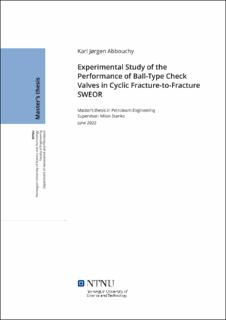| dc.description.abstract | One of the proven high recovery gas EOR techniques is the single-well fracture-to-fracture method, where injection and production of gas happens in an asynchronous, cyclic way through alternating injection and production fractures along the wellbore (F2Fcyc). Remotely activated valves or sliding sleeves placed in front of the injection and production fractures can be replaced by ball-type check valves that do not require any expensive actuation mechanisms and connectivity to the surface. This aims at reducing completion costs, giving the F2Fcyc higher economic merits over other gas EOR methods. The valves in front of the injection fractures (injection valves) will only open during injection, and the valves in front of the production fractures (production valves) will only open during production.
The opening and closing of those floating ball-type check valves is governed by flow and pressure. There will be losses in volumetric (and therefore injection and production) efficiency due to the closing delays of and leakages across the check valves when the well is alternating between injection and production modes. This can be crucial to the utilization of the injection fluid, recovery factors, and the economics of the EOR project.
This main aim of this thesis is to study and quantify experimentally the leakage and closing performances of the injection and production ball-type check valves through leakage tests and closing rate tests respectively. The leakage test is conducted by measuring leakage rates through the closed valves at certain differential pressures. The closing rate test is conducted by measuring the rate needed to push the ball towards the valve’s seat and the amount of fluid lost prior to the valve’s closure. Air and nitrogen are used as the working fluids. Two setups were used: a high-pressure setup and a low-pressure setup. Both setups are used for leakage tests, but only the high-pressure one is used for closing rate tests. A dimensionless analysis was carried out to analyze the leakage test results in both setups.
Leakage rates at certain pressure differentials through the closed valves in both setups fell below the NORSOK’s leak rate acceptance criteria for gas. The leaked gas prior to the closure of the valves in the high-pressure setup during the closing rate test also fell below the accepted leakage rate. The dimensionless analysis showed that the seat and ball roughness have a noticeable effect on leakage rates through the valves. Leakage rates through the high-pressure injection and production valves reached a critical differential pressure after which the valves continue to leak at a lower rate at higher differential pressures. This indicates that a good seal between the ball and the valve’s seat is established at high differential pressures. This limits the volumetric losses, therefore improving the economics of the F2Fcyc method. | |
